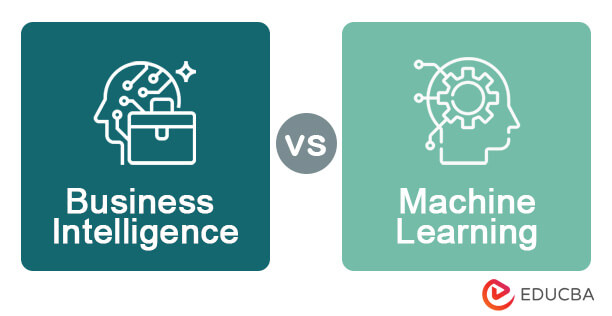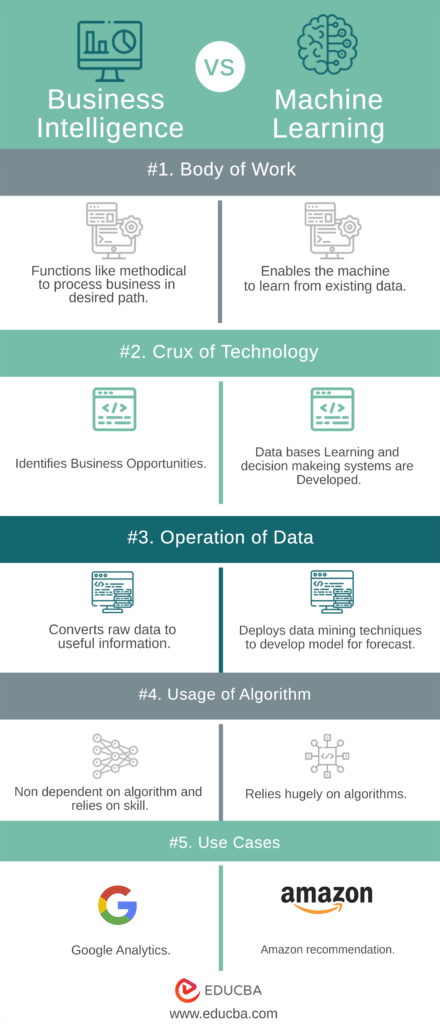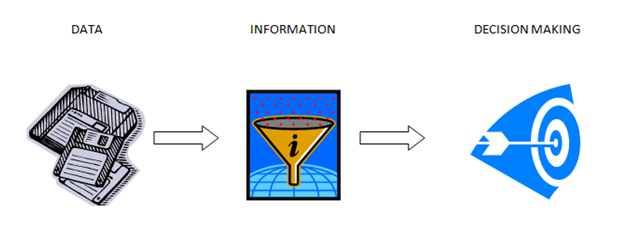Updated May 3, 2023

Difference Between Business Intelligence And Machine Learning
BI (Business Intelligence) has become an important area of study in Data Analytics. And to accomplish that task of finding success with respect to business strategies, taking time to collect, analyze, interpret, and act on data should be the only goal. Business Intelligence actually differs from traditional and Modern approaches Modern BI makes business users create their own content without depending on someone on IT, whereas traditional BI leans heavily on IT professionals.
Machine learning, a definition, is as simple that it’s a machine or a system that gives perfect output based on the input. In recent years, this has become a common buzzword. Before machine learning, computers had to be programmed (directions were to be given). After the invention of machine learning, computers can think for themselves. Organizations noticed new discoveries and solved issues by using this machine-learning technique.
The famous writer quoted machine learning as
“Software with machine learning doesn’t do the same thing the day you install it as it does the tenth or hundredth day you run it.”
Head to Head Comparison between Business Intelligence and Machine Learning (Infographics)
Below are the Top 5 comparisons between Business intelligence vs Machine Learning.
Key Differences Between Business Intelligence and Machine Learning
Machine Learning (ML)
The work routine of ML is quite simple
- We feed data and train the system with the help of algorithms and models
- Once the system gets familiar with the data, it generates the target predicted outcome with respect to the known set of data
Now we shall try to have an understanding of how ML is categorized and the respective functionalities of its learning:
| Characteristics | SUPERVISED LEARNING | UNSUPERVISED LEARNING | REINFORCEMENT LEARNING |
| Data | Labeled data | Unlabeled data | Iterative |
| Prediction | Based on prior knowledge | Without prior knowledge of the data | Based on interactions from previous experiences |
| Significance | Predictive model | Descriptive model | Performance-based on experience |
- Supervised LEARNING: Predicts output for new data based on previous knowledge of data sets. Here the scientist feeds data and expects the outcome to the machine.
- Unsupervised LEARNING: This case generally occurs when one does not know what to expect from the data. With input data, it tries to detect patterns, cluster the algorithms, and summarize the data points for the scientist to derive the outcome through meaningful insights.
- Reinforcement LEARNING: Here, the machine focuses on interactions within the environment and predicts the outcome by incorporating the interactions.
ML identifies human patterns which are tough to trace in huge masses of data. For any organization, ML brings the opportunity to the following aspects:
- User get value results faster for their BI projects
- Making products more suggestive
- To lower the implementation complexities
Business Intelligence (BI)
This term generally refers to the technologies, applications, and practices to provide strategic decisions to the business. The functionality of the BI is quite simple too. It needs data to work on.
However, the data present here is not simple. We are talking about Big-Data. This Big-Data needs to be visualized in order to provide efficient business opportunities. Below is a simple representation of how Business Intelligence (BI) operates:
BI is often used for 2 purposes:
- Purpose 1. Run the business
- Purpose 2. Change the business
Here we will try to understand how BI is applied to both the purposes and their characteristics constituting the same:
| Characteristics | Purpose 1 | Purpose 2 |
| Data | Structured data sources | A mixture of structured & unstructured data sources |
| Support | Better data quality is required | Can function with less qualified data |
| Focus | Directed towards data standards & management | Directed towards data mining & opportunity seeking |
| Speed | Less important | Relies on speed & agility |
Business Intelligence vs Machine Learning Comparison Table
Comparing machine learning with business intelligence is a bit tough task because machine learning is set to unlock the power of business intelligence. Business Intelligence (BI) focuses on analyzing the data on its own (ML doesn’t have this skill). This unique skill set, it predicts the outcome of a business strategy that is more reliable for the syndicate to be influenced by rather than their guts and feelings.
BI is a wonderful concept for organizations to make use of information smartly. Here, the results of strategies are based on the data and not on one individual’s instincts. On the other hand, Machine Learning (ML) functions as per the terminology. Its functionality is more like making the systems understand without any explicit programming.
In simple dialectal, the machine focuses on learning by itself via accessing the data present to them and transforming that data into information. The below table helps you understand what significance Business Intelligence and Machine Learning pose to each other:
| Features | Business Intelligence | Machine Learning |
| Body of work | Functions like methodical to process business in the desired path | Enables the machine to learn from existing data |
| Crux of technology | Identifies business opportunities | Data-based learning and decision-making systems are developed |
| Operation of data | Converts raw data into useful information | Deploys data mining techniques to develop models for forecast |
| Usage of algorithm | Non-dependent on an algorithm and relies on skill | Relies hugely on algorithms |
| Use cases | Google Analytics | Amazon recommendations |
Conclusion
The significance of the Business Intelligence and Machine Learning offer is directly proportional to the dependency on data (structured/unstructured). This is the only uphill task that needs to be sorted out (not easy) as it relies on the availability of efficient data and quality algorithms.
Hence it is the job of the organization to make use of structured & unstructured data and strive towards designing fresh algorithms that are more effective and capable of working on for these tools to offer the desired outcome. However, the people who head businesses need to concentrate more on this field, as addressing these challenges is the only way to go forward.
Recommended Article
We hope that this EDUCBA information on “Business Intelligence vs Machine Learning” was beneficial to you. You can view EDUCBA’s recommended articles for more information.


